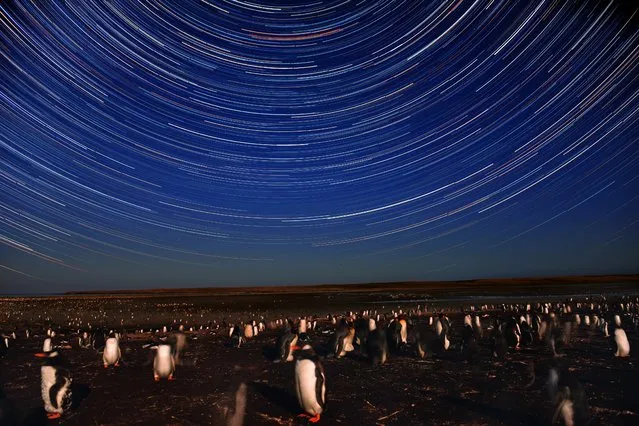
A composite of 216 images shows the trail of stars over colonies of Gentoo and King penguins on Friday, February 19, 2016, in Bluff Cove, Falkland Islands. Hattie and Kevin Kilmartin own 35,000 acres of land along 20 miles of due-south-facing coastline that encompasses Bluff Cove, where they offer guided day tours to cruise ship visitors to the Falkland Islands. When Kevin bought the land in 1980, he ran a traditional Falklands sheep farm selling wool on the international market. In 2002, he and his wife diversified into tourism. He says, “Tourism is the thing that has revolutionized the farm economy. When we were buying the farm as a sheep farm, it never occurred to anybody at all that they (penguins) were going to play any part whatsoever in the finances of the farm. They were nice to have, nice to visit occasionally. That's all we thought. We certainly didn't think there was a business there. Were the cruise ship not to come anymore, there wouldn't be a business. It's all totally based on cruise ships”. Kilmartin said that in 2002 “Holland America (a cruise ship business) got ahold of us. They were bringing down their first ship to the Falklands...They said “We need a penguin tour. What can you guys do”? We said we don't do penguin tours. After a bit of persuading, we gave them a penguin tour and we enjoyed it, they enjoyed it , and we've been doing it ever since”. (Photo by Jahi Chikwendiu/The Washington Post)
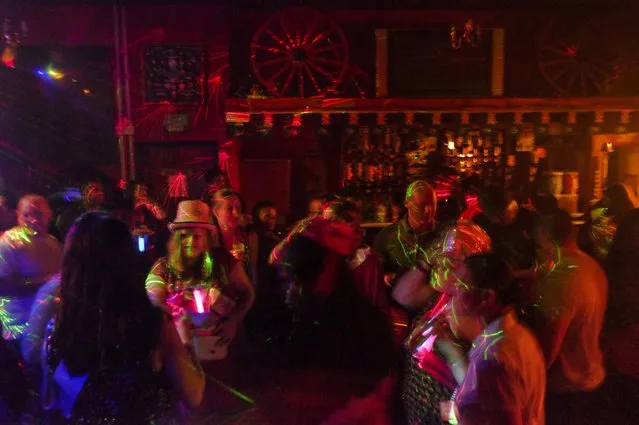
Patrons gather for drinks and dancing at the Globe Tavern on Saturday, February 6, 2016, in Stanley, Falkland Islands. (Photo by Jahi Chikwendiu/The Washington Post)
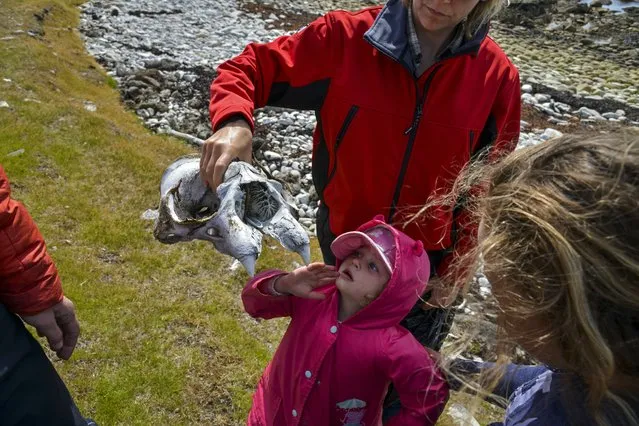
Xenia Cleminson, 3, curiously peers at an elephant seal skull found during an beach excursion on Sunday, February 7, 2016, on Elephant Beach, Falkland Islands. Xenia is the daughter of Falklands Conservation's CEO, Esther Bertram. The child was one of more than 30 children who visited the beach that day to pick up trash as part of Falklands Conservation's Watch Group, an environmental organization that takes kids on field trips and camping excursions. (Photo by Jahi Chikwendiu/The Washington Post)
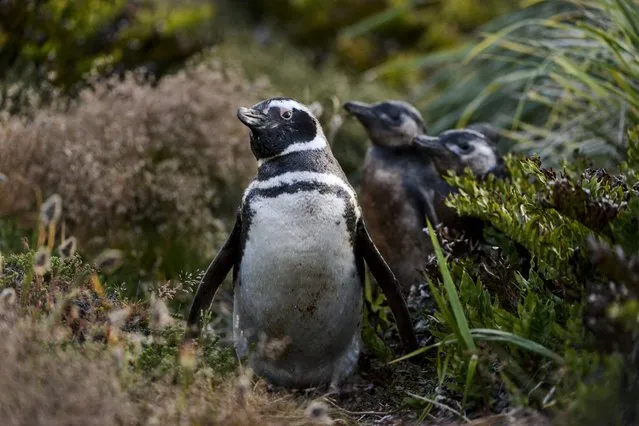
Magellanic penguins, an adult and two youth, curiously venture from their burrow on Sunday, February 7, 2016, in Gypsy Cove, Falkland Islands. At an approximate 10 minute drive from Stanley, Gypsy Cove is the closest wildlife destination to reach from the capital. (Photo by Jahi Chikwendiu/The Washington Post)
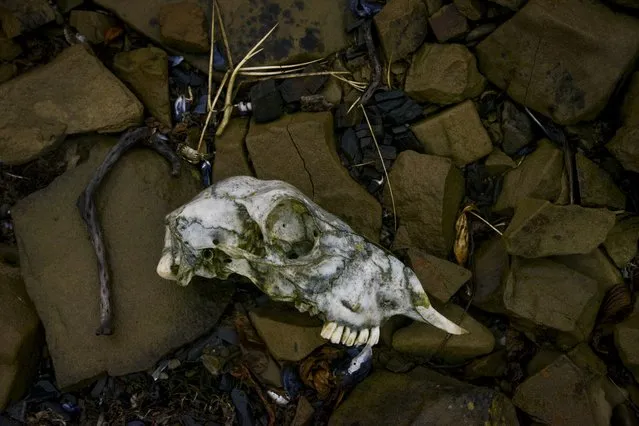
A sheep skull rests on a bed of rocks near the Argentine Military Cemetery on Monday, February 8, 2016, in Darwin, Falkland Islands. Nearly half a million sheep populate the islands compared to roughly 2,500 people. (Photo by Jahi Chikwendiu/The Washington Post)
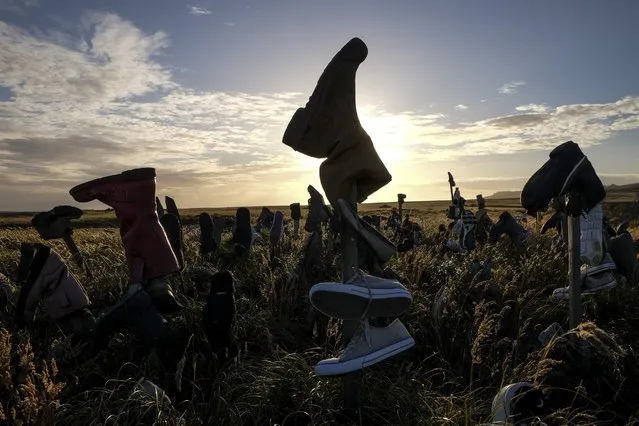
An ever-growing garden of shoes sprouts in a field just outside the capital city on Wednesday, February 10, 2016, in Stanley, Falkland Islands. The shoes are said to be left by visitors promising to return for the items they left. (Photo by Jahi Chikwendiu/The Washington Post)
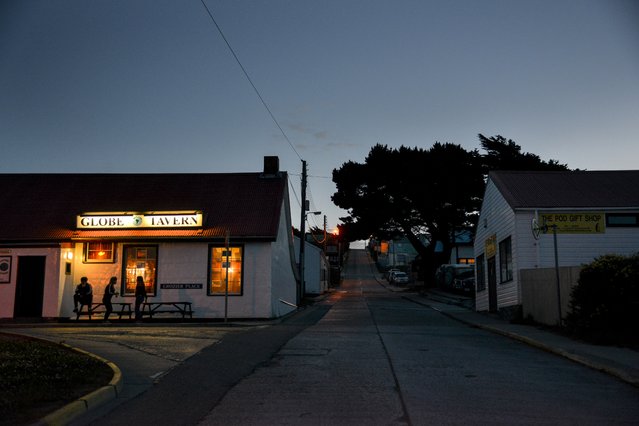
Just after sunset, patrons gather for food, fun, dancing and drinks at the Globe Tavern on Wednesday, February 10, 2016, in Stanley, Falkland Islands. (Photo by Jahi Chikwendiu/The Washington Post)
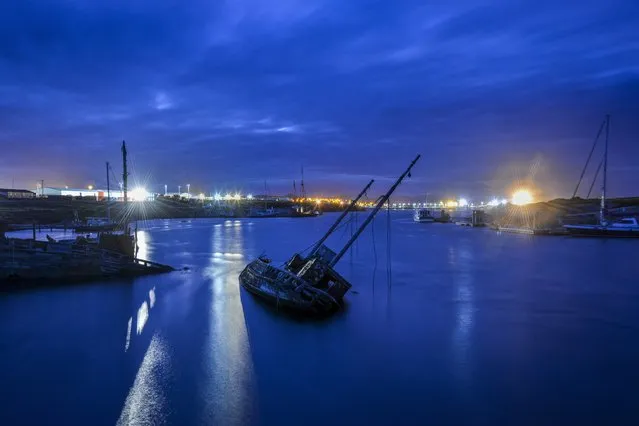
A partially-sunken fishing boat rests in the Stanley Harbor on Wednesday, February 10, 2016, in Stanley, Falkland Islands. While oil exploration has started in the waters around the islands, fishing remains the country's main economic contributor. (Photo by Jahi Chikwendiu/The Washington Post)
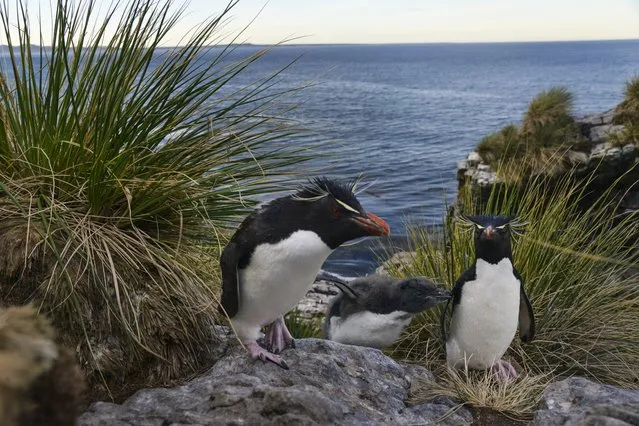
A family of Rockhopper penguins nests at the top of the island's north-facing cliffs on Thursday, February 11, 2016, in Kidney Island, Falkland Islands. The rockhopper penguin is the smallest but most agile of the Falkland penguins. (Photo by Jahi Chikwendiu/The Washington Post)
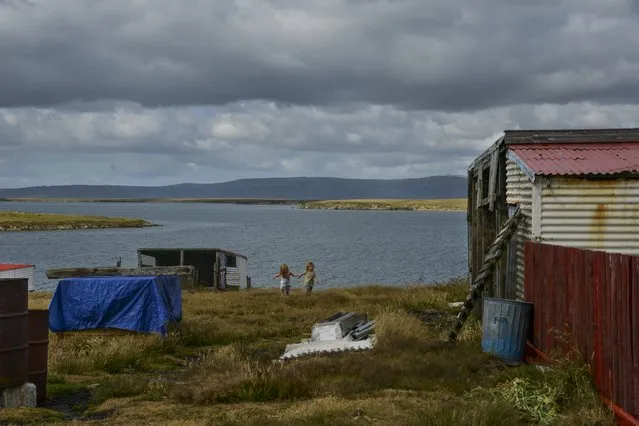
Sisters, Eden and Charleigh Molkenbuhr, skip along near their family's home on Friday, February 12, 2016, in Johnson's Harbour Farm, Falkland Islands. Growing up on the Falklands Islands offers children a unique experience where wildlife and livestock, such as penguins and sheep, outnumber people on these islands that are sparsely populated by humans. (Photo by Jahi Chikwendiu/The Washington Post)
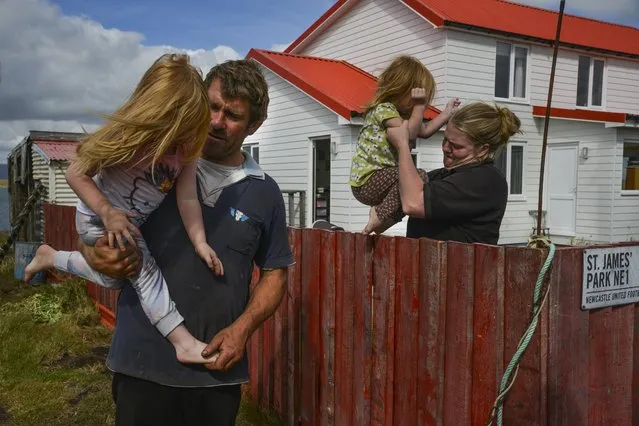
Eden Molkenbuhr, 3, L, is held by her father, Lee Molkenbuhr, as her sister, Charleigh Molkenbuhr, 2, is lifted into their family's yard by their mother, Martha Molkenbuhr, on Friday, February 12, 2016, in Johnson's Harbour Farm, Falkland Islands. (Photo by Jahi Chikwendiu/The Washington Post)

An adult King penguin tends to a youngster as a large colony of King penguins nests on Friday, February 12, 2016, on Volunteer Point, Falkland Islands. King penguins are the largest of the Falklands penguins, with the bulk of the islands' breeding adults concentrated almost entirely at Volunteer Point. At an average height of just over three feet tall, King penguins are the second largest species of penguin. Only the Emperor penguin is bigger. (Photo by Jahi Chikwendiu/The Washington Post)
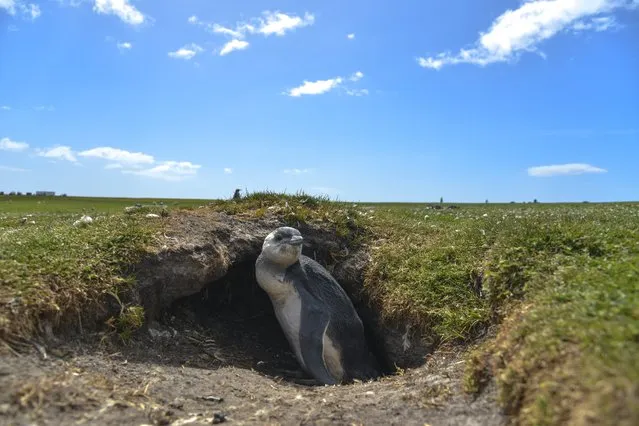
A young Magellanic penguin sits at the mouth of its burrow on Friday, February 12, 2016, on Volunteer Point, Falkland Islands. This type of penguin visits the Falklands only in the summer, breeding in burrows dug into soft soil or peat usually on slopes facing the sea. (Photo by Jahi Chikwendiu/The Washington Post)
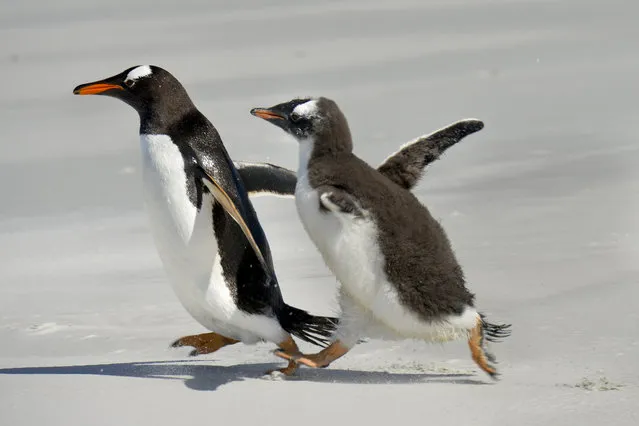
An adult Gentoo penguin in closely chased by a juvenile of the same type on Thursday, February 11, 2016, on Bertha's Bearch, Falkland Islands. Gentoo penguins are the most numerous in the islands and, standing at an average of 2.5 feet, they're the islands' second largest penguins to only the King penguin. The beach, one of the finest wildlife sites in the Falkland Islands, was named after the ship Bertha, a 500 ton iron barque that was wrecked here in 1892. (Photo by Jahi Chikwendiu/The Washington Post)
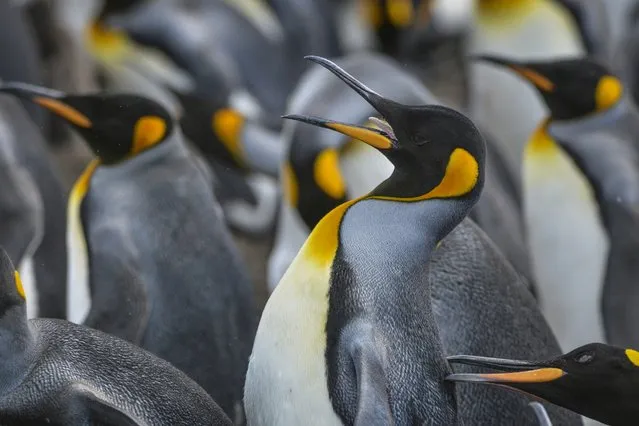
King penguins closely guard their space as a large colony nests on Friday, February 12, 2016, on Volunteer Point, Falkland Islands. (Photo by Jahi Chikwendiu/The Washington Post)
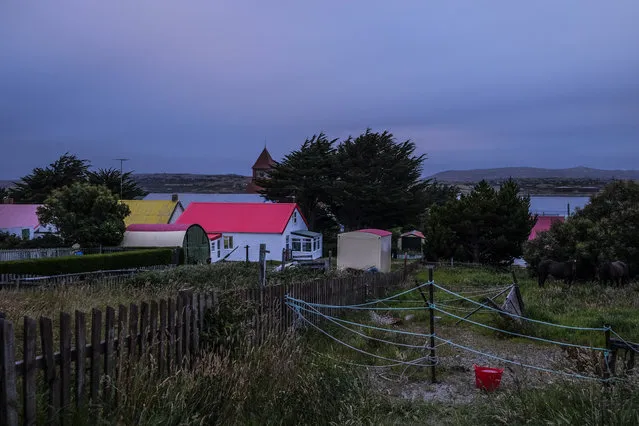
Dusk settles just off the main street of the capital near the Stanley Harbour on Friday, February 12, 2016, in Stanley, Falkland Islands. The town is home to a around 2,000 of the sparkly populated islands' nearly 3,000 people. (Photo by Jahi Chikwendiu/The Washington Post)
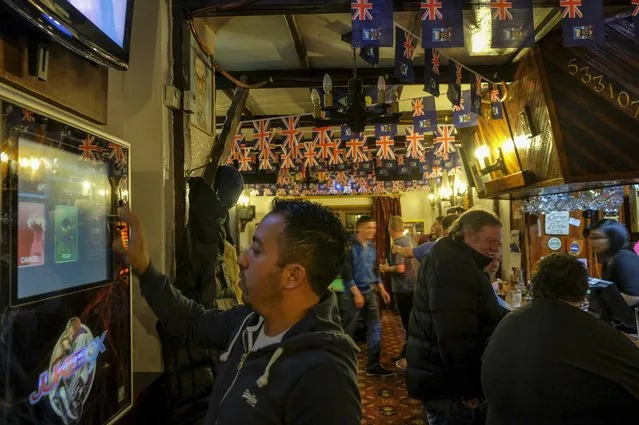
Jukebox tunes are chosen as patrons gather to drink and socialize at the Victory Bar on Friday, February 12, 2016, in Stanley, Falkland Islands. The town is home to a little more than 2,000 of the islands' nearly 3,000 people. The Falkland Islands are a remote territory of Britain, as can be seen from the symbols of its country's flag. While the islands have been under the control of multiple countries over the years, control was retained by Britain after Argentina invaded and occupied the islands in 1982. (Photo by Jahi Chikwendiu/The Washington Post)
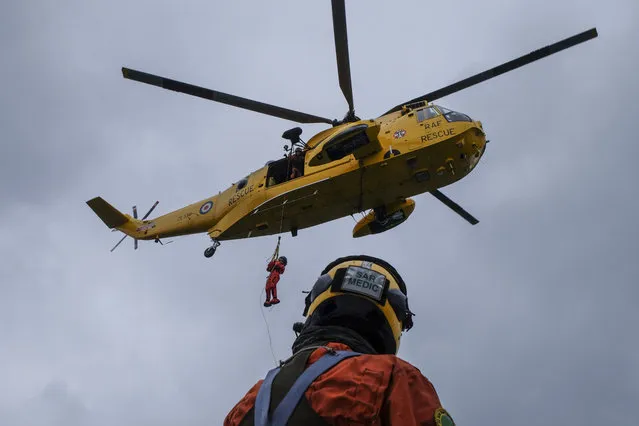
Emergency personnel perform rescue drills on a ferry crossing Falkland Sound, the waterway that separates East Falkland from West Falkland on Saturday, February 13, 2016, in Port Howard, Falkland Islands. (Photo by Jahi Chikwendiu/The Washington Post)
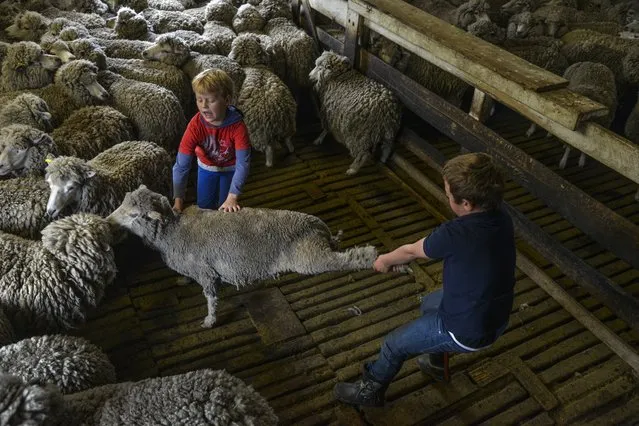
George Lee, R, and his cousin, Daniel Lee, work to separate sheep that have already been shorn from those who will soon have their thick wools removed at the family's shearing shed on Saturday, February 13, 2016, in Port Howard, West Falkland Islands. Their family owns 40,000 sheep and 300 cows. During weekends and school breaks, George throws himself into country life, away from where he attends school during the week in the islands' capital, Stanely. (Photo by Jahi Chikwendiu/The Washington Post)
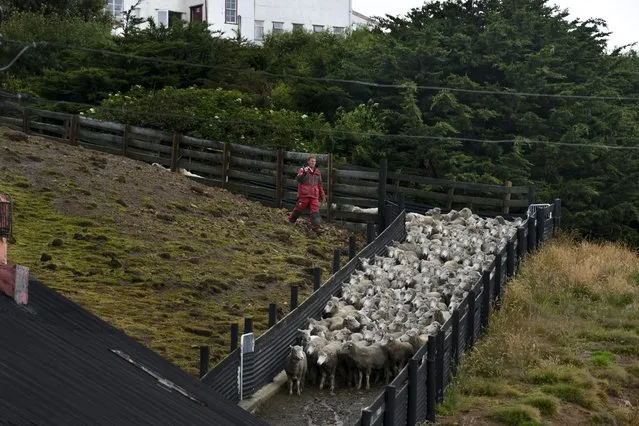
A member of the Lee family drives sheep into the family's shearing shed on Saturday, February 13, 2016, in Port Howard, West Falkland Islands. Their family owns 40,000 sheep and 300 cows on 230,000 acres of land. Nearly half a million sheep populate the islands compared to roughly 2,500 people. (Photo by Jahi Chikwendiu/The Washington Post)
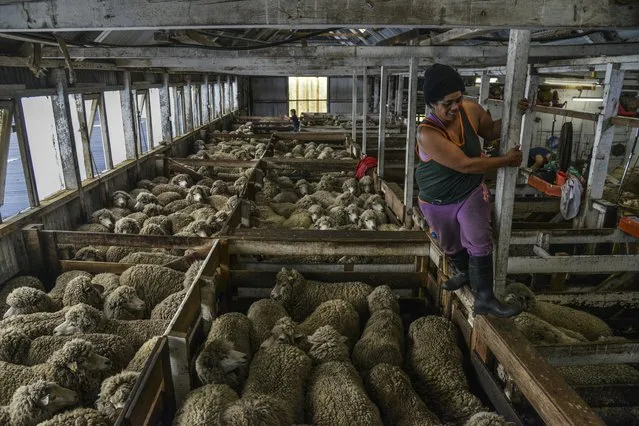
During shearing season, alternative routes are taken around shearing sheds as a group of mainly seasonal workers shear and sort sheep wool on the property of the Lee family on Saturday, February 13, 2016, in Port Howard, West Falkland Islands. (Photo by Jahi Chikwendiu/The Washington Post)
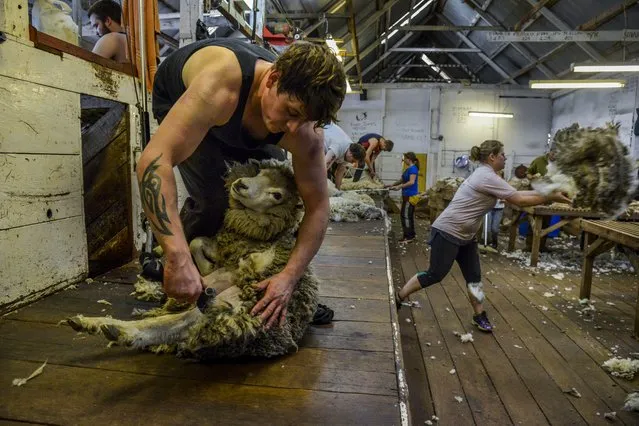
A group of mainly seasonal workers shear and sort sheep wool on the property of the Lee family on Saturday, February 13, 2016, in Port Howard, West Falkland Islands. Some shearers, such as Barry Cockburn, 27, front, travel from as far away as Scotland. (Photo by Jahi Chikwendiu/The Washington Post)
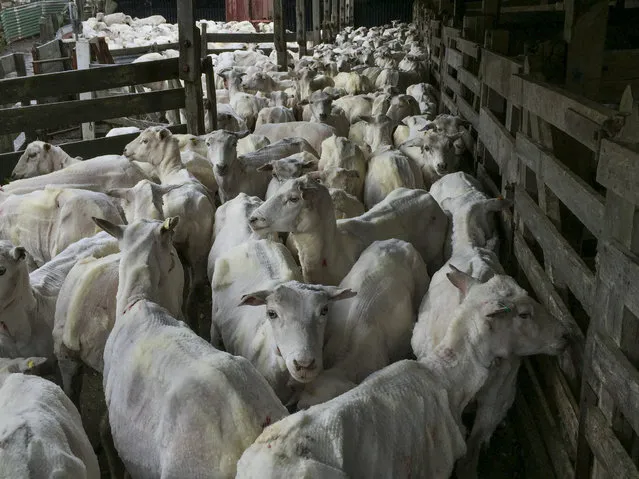
Freshly shaven sheep are corralled before being released on the farm of the Lee family in Port Howard, West Falkland Islands, on Saturday, February 13, 2016. About 99 percent of the extremely sparse land in the Falklands, which includes more than 700 islands, is privately owned. (Photo by Jahi Chikwendiu/The Washington Post)
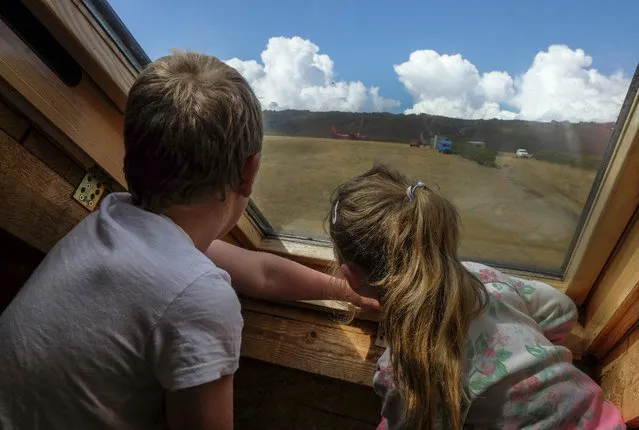
George Lee and sister Anna Lee watch from the sky light window of their home as an inter-island plane lands just behind their family's farm house on Sunday, February 14, 2016, in Port Howard, Falkland Islands. Port Howard is the main settlement on West Falkland Island. During the week, the children attend school in Stanley, the country's capital on East Falkland Island. Their school transport options: either take a ferry and drive two hours or take a small plane that might make multiple island stops along the way. (Photo by Jahi Chikwendiu/The Washington Post)
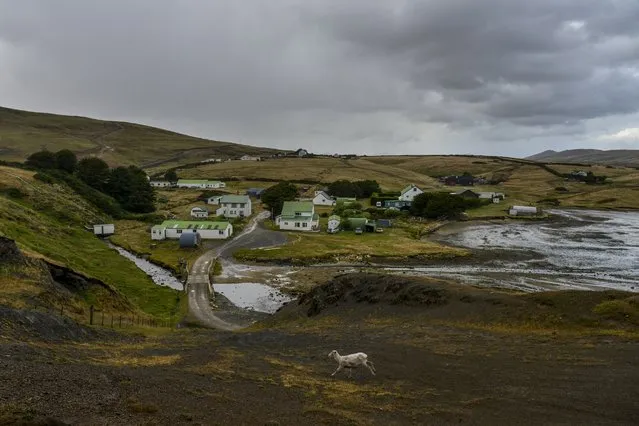
A freshly shorn sheep makes its way across the cold and wet settlement on Saturday, February 13, 2016, in Port Howard, Falkland Islands. With a population of 30 people, Port Howard is the largest settlement on West Falkland. Nearly half a million sheep populate the islands compared to roughly 2,500 people. (Photo by Jahi Chikwendiu/The Washington Post)
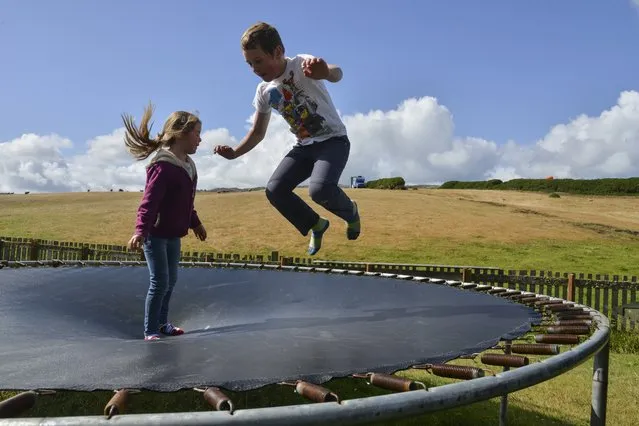
Anna Lee, L, and brother George Lee jump on the family trampoline in the back yard on Sunday, February 14, 2016, in Port Howard, Falkland Islands. (Photo by Jahi Chikwendiu/The Washington Post)
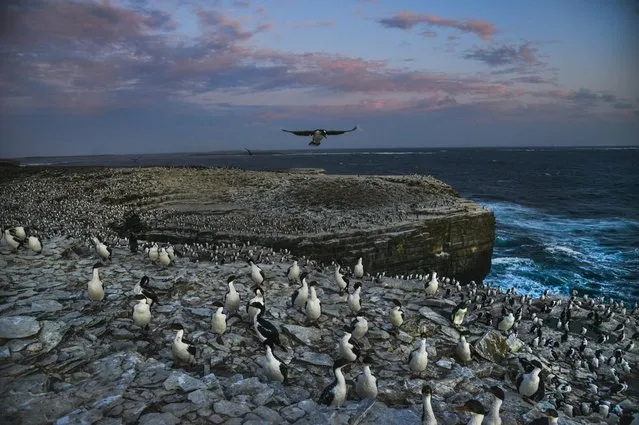
As the sunlight fades, thousands of Imperial Cormorants, with a sprinkle of Rockhopper penguins, nest along the cliff tops of the southernmost part of the island on Tuesday, February 16, 2016, in Sea Lion Island, Falkland Islands. Sea Lion Island is the southernmost human-inhabited island of the Falklands. (Photo by Jahi Chikwendiu/The Washington Post)
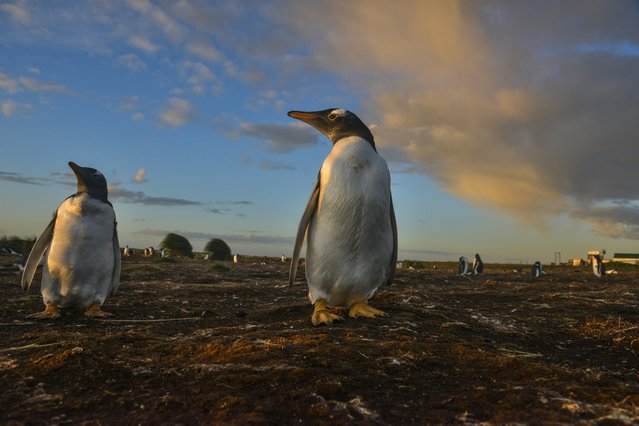
As the sun rises, Gentoo penguins start their day on Wednesday, February 17, 2016, on Sea Lion Island, Falkland Islands. Sea Lion Island, which lies about 10 miles to the south of mainland East Falkland, is the southern most human-inhabited island of the more than 750 islands and islets of the Falkland Islands. (Photo by Jahi Chikwendiu/The Washington Post)
02 Sep 2016 13:05:00,
post received
0 comments
